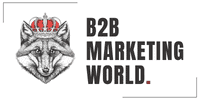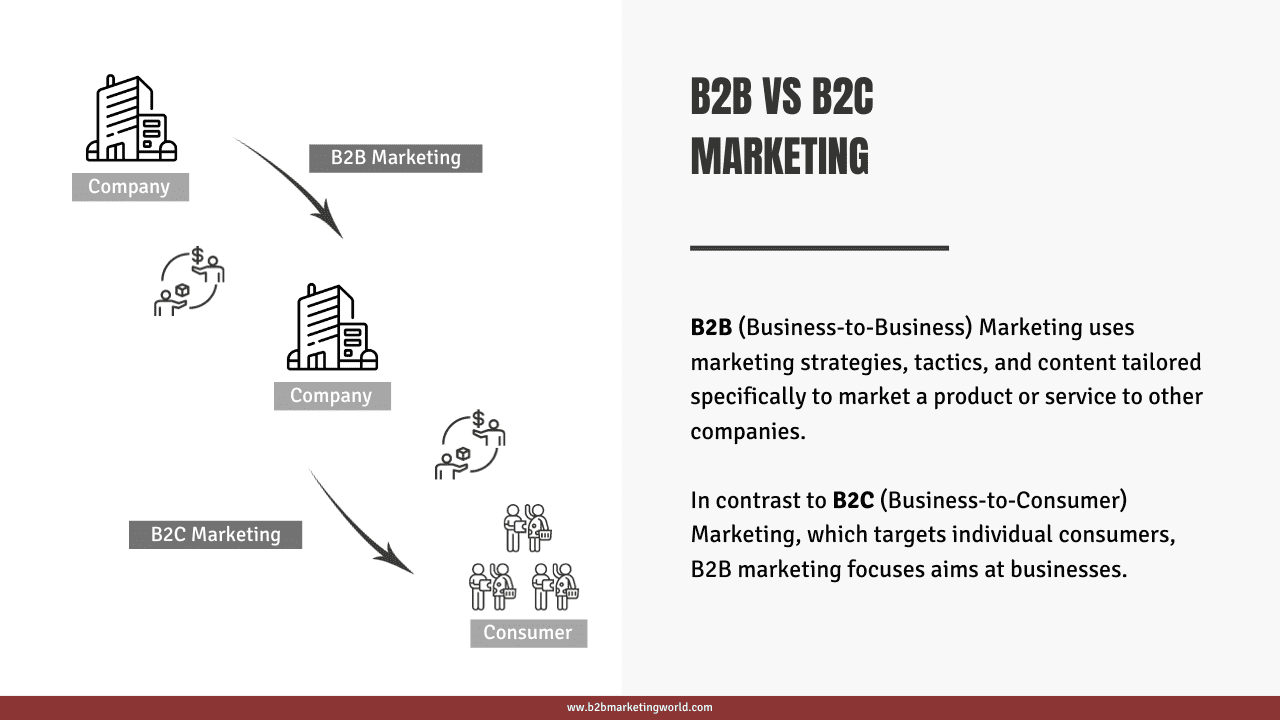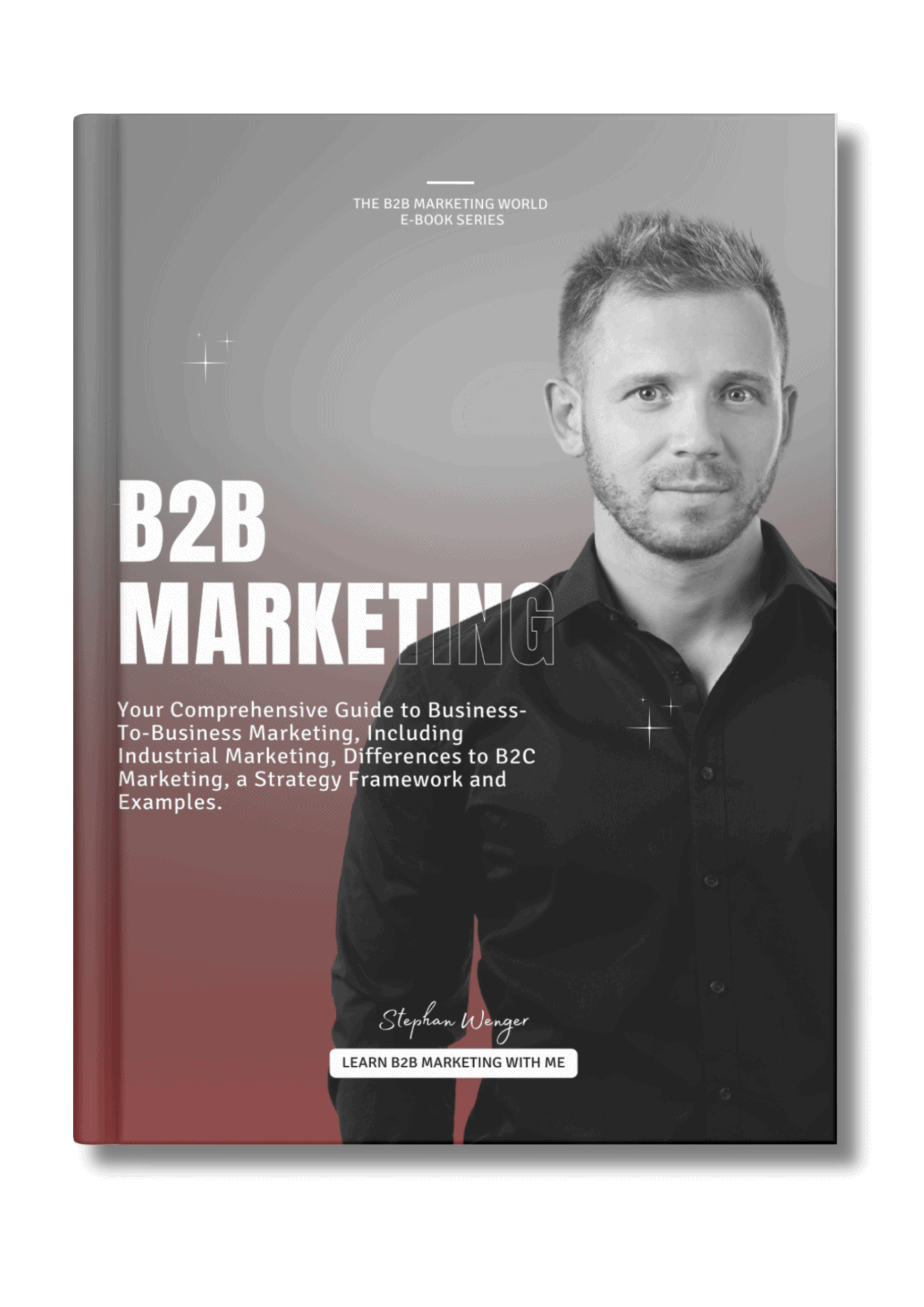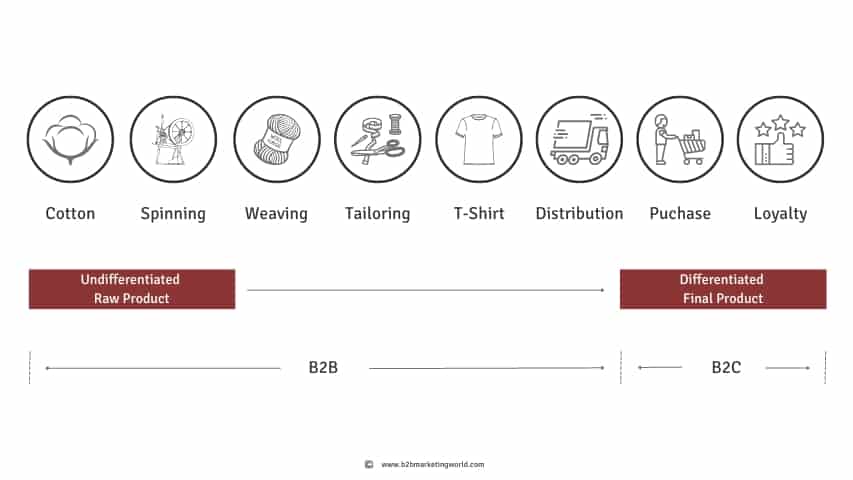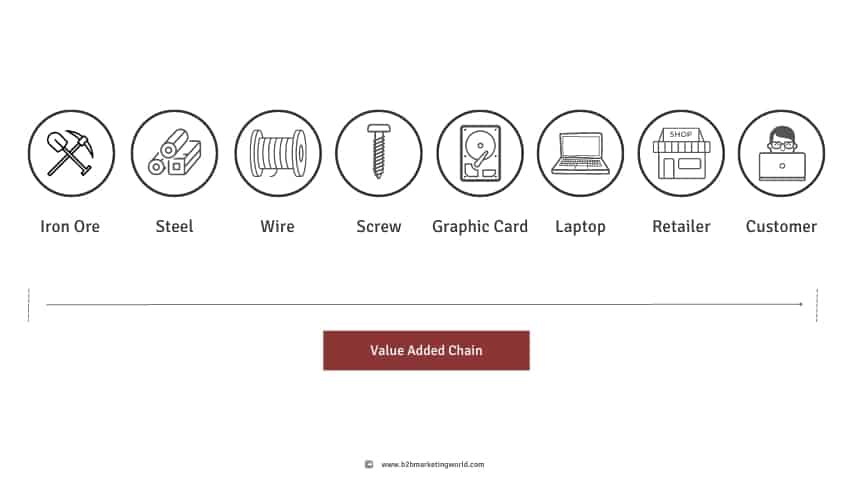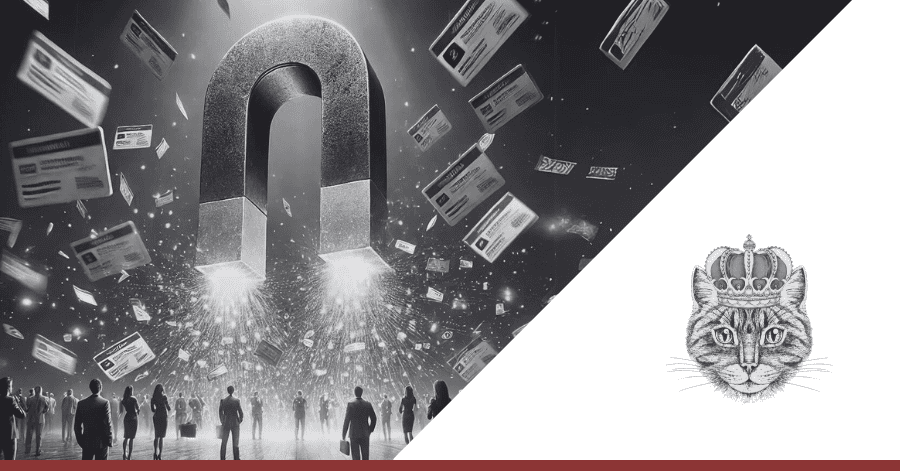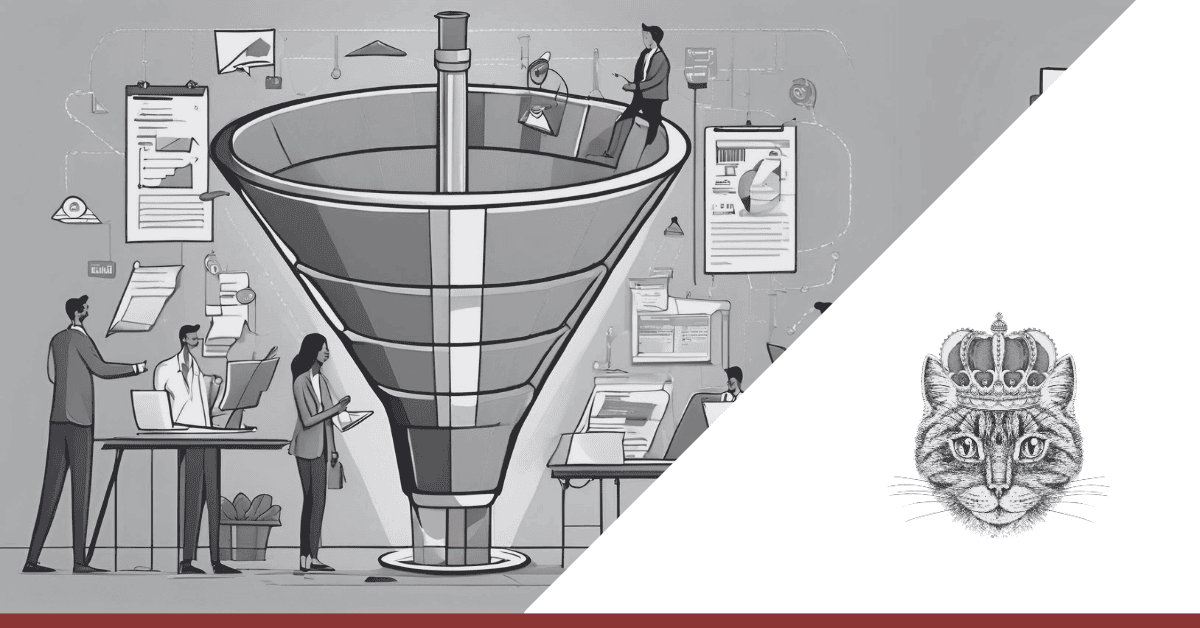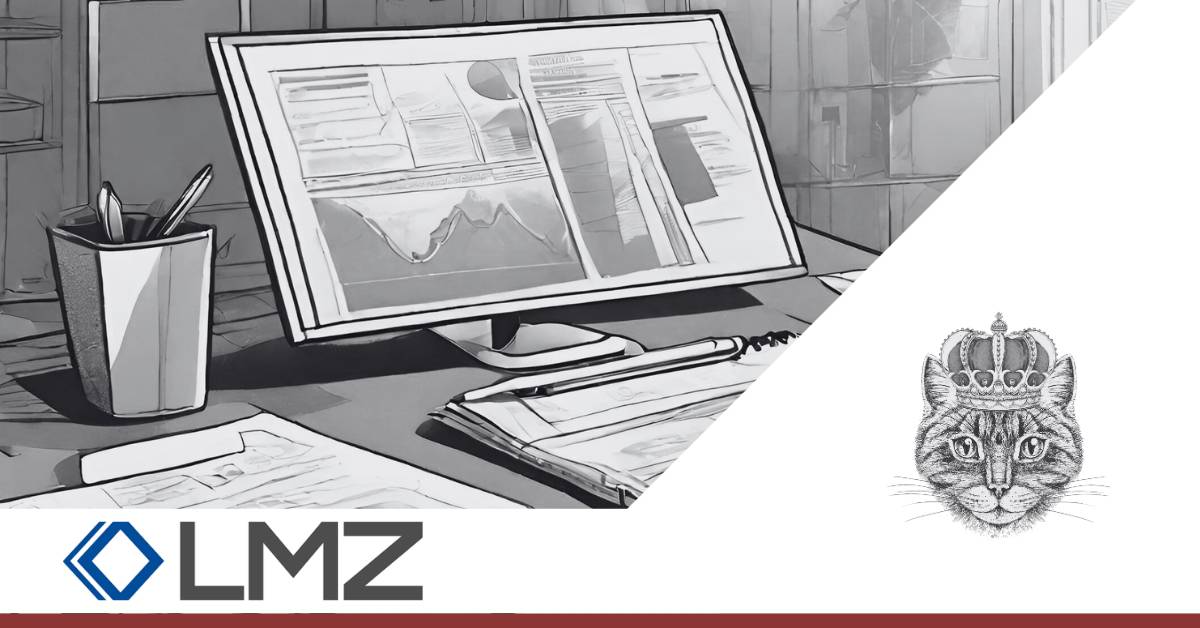Differences B2B and B2C Marketing
A Guide on Business-to-Business and Business-to-Consumer Marketing
No time? Read Summary
Table of Contents
Subscribe to our Newsletter and Learn B2B Marketing.
B2B marketing focuses on marketing strategies, tactics, and content tailored to promote products or services to other businesses. On the other hand, B2C marketing uses strategy and tactics to market directly to consumers.
B2B and B2C marketing share similar principles but differ in various aspects. The key differences include product complexity, emotional level of communication, price sensitivity and range, decision-making, and sales process.
B2C vs B2B Marketing © B2B Marketing World
We also dive into the differences between B2B vs. B2C marketing, looking at it from the perspective of the 4Ps of Marketing, also known as the Marketing Mix. We explore how B2B and B2C marketing vary across important marketing channels like online marketing, content marketing, and social media marketing, as well as traditional methods like events and print campaigns.
One way to bring a fresh perspective to your B2B marketing is by applying B2C marketing tactics.
Let’s go.
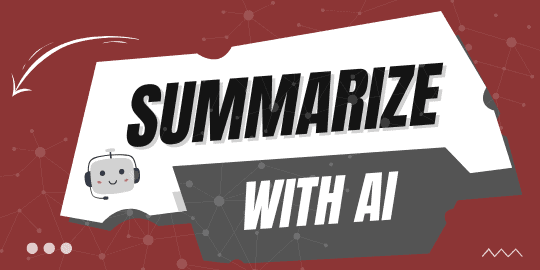
B2B vs B2C Marketing
See Differences and Similarities of Business and Consumer Marketing
Most marketing definitions describe the business relationship between a company and its customers and the strategies and actions to influence it.
The customer is, therefore, a differentiating criterion. We explain further differences between the two market types in the article on B2B vs B2C, markets and customers.
What is B2B Marketing
B2B (Business-to-Business) Marketing uses marketing strategies, tactics, and content tailored specifically to market a product or service to other companies.
Business-to-business marketing describes all activities a company does to market a product or service to another company and positively influences the business relationship between the two companies.
By trend, decisions are made less emotionally. The purchaser is less price sensitive, and the product or service is complex and has a high explanatory effort. The relationship is built on a personal connection and has a long-term perspective.
Modern B2B marketing has many aspects described in this article about What B2B marketing is.
What is B2C Marketing
B2C (Business-to-Consumer) Marketing is all a company’s marketing strategies and tactics to market a product or service to consumers to fulfill their needs.
B2C marketing focuses on the relationship between a company and the consumer of a product or a service.
By trend, consumers are influenced by emotions, are price sensitive, and make subjective decisions. Consumers do not necessarily seek long-term partnerships or try to make deals in the long run.
5 Key Differences between B2B and B2C Marketing
Both marketing disciplines have similar marketing principles. However, the differences between B2B and B2C markets and customers result in distinct differences.
The 5 key differences between business and consumer marketing are:
B2B vs B2C Marketing Compared [Infographic]
Use this infographic to understand B2B vs B2C Marketing from a big picture perspective.
![5 Key Differences B2B and B2C Marketing [Infographic] 5 Key Differences B2B and B2C Marketing [Infographic]](https://www.b2bmarketingworld.com/wp-content/uploads/5-Key-Differences-B2B-and-B2C-Marketing-Infographic.png)
Infographic: B2B vs B2C Marketing © B2B Marketing World
![5 Key Differences B2B and B2C Marketing [Infographic]_focuscut 5 Key Differences B2B and B2C Marketing Infographic](https://www.b2bmarketingworld.com/wp-content/uploads/5-Key-Differences-B2B-and-B2C-Marketing-Infographic_focuscut.png)
Download this free Infographic!
B2B vs B2C Marketing: Branding
The Importance of the Brand for Marketing
It is a common misperception that companies sell products. Companies sell fulfillment of customers’ needs. Both in B2B and B2C.
Yes, this is achieved by a product or service.
But the good itself is not the core reason for the purchase. Customers ask themselves with every purchase: “Is the product able to fulfill my need?”.
The question is, how do we influence customer perception?
The answer is Branding.
Branding in B2C Marketing
Let us quickly recall B2C marketing key aspects: the target group is consumers, products are price sensitive and fulfill personal needs, communication is emotional, and decisions are made by the consumer and often happen at the point of sale after a short sales circle time.
Further, markets are saturated, competition is fierce, and product distinction is tricky.
Therefore, the focus of B2C branding lies on creating a brand experience that is:
- Personal
- Emotional
- Trustworthy and Believable
- Rememberable
- Enjoyable
The most outstanding B2C branding examples are not product-centric but story-centric.
Here’s an example of a famous Coca-Cola vs. Pepsi advertisement of both companies:
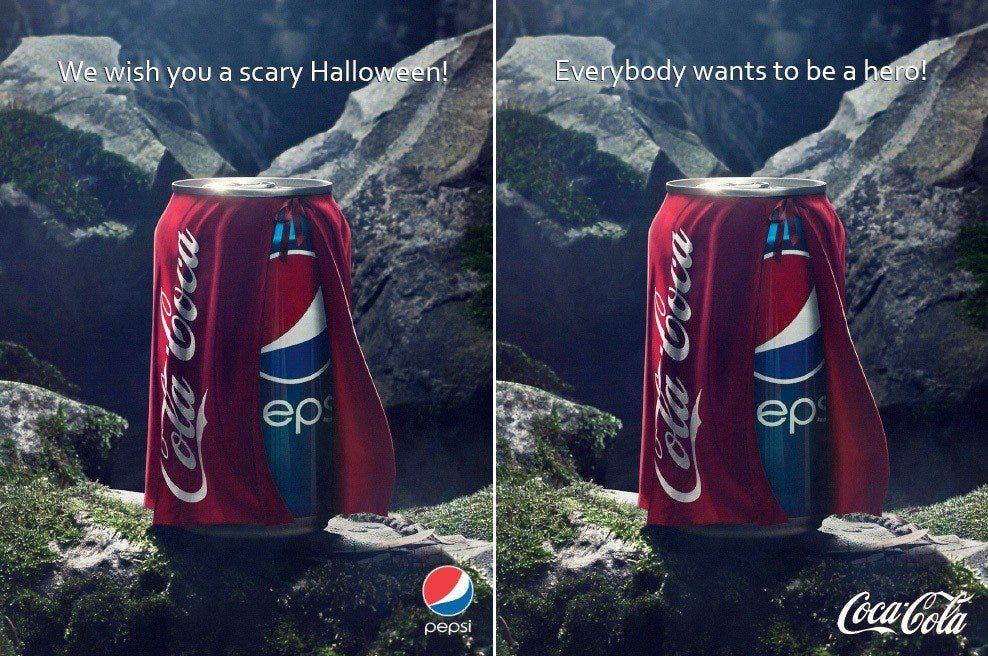
Example of B2C advertisement Coca-Cola vs. Pepsi © Bettermarketing
Branding in B2B Marketing
To get into the right mood, let us recall B2B marketing’s key characteristics: target groups are companies, and products are high-priced and often complex. Communication is fact-centric and heavy on, by trend, less emotional content. A buying center makes the purchase decision over a long period. Prices are not part of the game, and markets are often global niches.
The focus of B2B branding lies on establishing a relationship with the company that is:
- Personal
- Trustworthy and fact-driven
- On eye-level
- Purpose-driven
- Humanized
Personal
Like B2C, a B2B brand makes an unpersonal company more accessible. Personal interaction builds trust, and trust is essential in B2B relationships.
The brand helps to give your company a face and enables people to connect emotionally. This is important to keep your company on top of your mind.
Trustworthy and fact-driven
Trust leads to turnover. Your brand perception is an excellent way of conveying your expertise.
Thought Leadership is a great branding strategy to position your company as the most trustworthy company in the market. This is done by fact-driven positioning.
On eye-level
Honest communication is vital for a long-term business relationship. A great B2B brand conveys that you are at eye level with your customers.
The message is that you help them to achieve their goals by fulfilling their needs.
Purpose drive
A purpose-driven brand communication focuses on solutions instead of products. It gives your brand a reason to believe.
Your branding supports your company’s purpose and conveys the “reason why”.
Humanized
I have mentioned it – give your company a face. Include humans in your brand elements and give your employees a well-deserved spot in your brand communication. The positive effects will include more stable business relationships, stronger recognition, better job-market perception, etc.
B2B vs. B2C Marketing: Customer Relationship
Understand Customer Centricity and the Impact on B2B and B2C Marketing
No customers, no business.
This bold but true statement leads to the modern buzzword of customer centricity. For the differences between B2C and B2B Marketing, the customer is essential.
Therefore, we discuss the relationship between companies and customers.
B2C Builds Emotional and Transactional Customer Relationships
The chapter on branding provides a comprehensive overview of its key aspects. Branding serves as the bridge between a company and its consumers. In B2C marketing, branding aims to create a highly personalized, emotional, trustworthy, and enjoyable experience. Ideally, it is an experience that lingers in the memory.
Therefore, a company’s customer relationship is primarily driven by emotional factors. The objective is to generate sales by delivering a flawless brand experience. Both online and offline.
Due to the short sales cycle in B2C marketing (see details below), the aim is to prompt immediate purchases at the point of sale. The marketing process, from creating awareness to conversion, can often occur in a fraction of a second.
B2C marketing strategies revolve around positioning and selling products or services. Data and an array of multi-channel marketing approaches guide these tactics.
Leveraging emotional messaging helps establish top-of-mind awareness for future purchasing decisions, ideally leading to repeat business.
All these factors contribute to transactional-centric customer relationships.
B2B Builds Long-Term and Trust-Based Customer Relationships
In B2B marketing, we face an entirely different purchasing process. The following chapter details the topics of the long sales cycle, objective purchasing decisions by the buying center, and high-volume transactions.
These circumstances stand in contrast to emotional and impulsive buying decisions. In business markets, the buying decisions may take years and require mutual long-term agreements between buyer and seller.
Further, the B2B business largely builds on trust, standards, norms, and legal requirements. A strong customer relationship is important for successful and sustainable business growth. This holds true for both the seller and the buyer.
This leads to a customer relationship built on mutual trust that lasts years or even decades.
B2B vs B2C Marketing: Marketing Mix
The 4Ps of Marketing in Business and Consumer Marketing
The marketing mix, also called the “4Ps of Marketing,” is a great concept to grasp the essence of both marketing disciplines.
B2B vs B2C Communication
Marketing Communication or “Promotion” is essential to the marketing mix.
Often, this area is synonymously used for marketing and is the central marketing team’s responsibility.
Communication includes external, market-oriented communication (= customer communication) and internal, company-oriented communication (=employee communication).
B2B Marketing Communication
Communication in B2B is often described as less emotional, fact-based, and educational content driven. This type of content helps to establish credibility and build trust with potential clients.
However, the B2B marketing communication type differs significantly depending on the buying phase of potential customers.
The initial stage of raising awareness uses branded content and focuses on increasing awareness, followed by providing educational material.
During the action phase (see AIDA mode for details), the focus shifts to demonstrating the company’s ability to provide exceptional products and services. This
Promotional communication, such as testimonials or purely emotionally driven advertising, is less important than B2C marketing. Instead, the focus is on building trust to build strong client relationships. Product-centric communication evolves around facts, norms, and USPs.
B2C Marketing Communication
Simply put, many elements of consumer marketing communication stand contrary to business marketing communication.
Strong B2C brands use stories to spark emotions through a strong brand reputation and promise. You will see fewer facts than in B2B unless specific markets require it (e.g., the IT industry).
The focus is on the buying decision phase without necessarily educating the consumers upfront. Emotional and often irrational triggers rush consumers into a decision. B2C marketing communication positively influences these moments.
Micro-moments create a brand experience whenever a consumer contacts the B2C brand. Influencers help to generate these interaction points on a subtle, low-barrier level.
B2C vs B2B Price
The common perception is that prices are hidden in B2B and are used as central buying criteria in B2C. While this is true in essence, there are further aspects to it.
B2B Price Policy
B2B markets have a low price sensitivity. This means that price and sales are linearly connected. There is no disproportional de- or increase of sales when prices are de- or increased.
Companies commonly have a purchasing department to argue price and payment conditions. Large enterprises compare prices, and decisions require at least a second offer. Budget constraints and bidding processes influence the price, often required by law.
It is still common for B2B companies not to display prices online. Modern marketers criticize this principle. There is no need to hide prices, as (a) competition can easily find prices with fake purchases, and (b) customers know facts before starting an initial quote request.
B2C Price Policy
Price sensitivity in B2C markets can be high or low depending on the product category. Consumers have a hybrid price perception as soft facts such as branding, personal status, or perceived (promised) feature influence price sensitivity.
By trend, price is an emotionally influenced buying aspect. Consumers do not necessarily reason prices and compare with the created value.
Prices are known in B2C markets and are used by marketers for promotion purposes. Discounts are common.
There are multiple platforms to compare prices, estimate future price levels and guide consumers on whether it is a good time to buy.
B2B vs B2C Sales
The third “P” of the marketing mix is place or also referred to as distribution policy, commonly known as sales. Due to the nature of the target group, there are distinct differences between B2B sales and B2C sales:
B2B Sales and Distribution
Salespeople are vital success factors in B2B. The personal relationship is at the center of the buying process and often a critical criterion.
Due to the nature of the business, this group of employees are well trained and knows the functional principles of the product.
Salespeople often install products at the customer’s site and educate the customer. The knowledge is deep and requires training which makes sales and marketing people expensive.
The fluctuation rate is lower than in B2B, and loyal employees often are 100% convinced of the superiority of the product/service. The salesforce often is globally and organized in local company subsidiaries. This requires decentralizing sales management.
Getting the product to the customer can be tricky, especially globally. Shipping costs can be high due to heavy or bulky products.
The shipment may include dangerous goods and require special preparation. Typically, distribution is global but not decentralized.
That means global fulfillment processes out of centralized warehouses with high planning and managing demand. International expertise is required to handle aspects such as Incoterms, toll and tax-related aspects, and legal requirements.
B2C Sales and Distribution
The sales and distribution process differs from B2B for one main reason: the transaction happens between a company and a person. This aspect includes multiple, quite logical, implications. The natural behavior of a person defines the sales.
The sale happens online or offline. Offline purchases, or brick-and-mortar sales, happen in stores. The consumer can touch and try the product. There is no shipment needed as the buyer takes the product with him.
Ad hoc decisions at the point of sale (e.g., supermarket cashier) are common.
For online purchases, fast delivery and 24/7 accessibility to the products and services are state-of-the-art. The fulfillment is often on the doorstep.
B2B vs B2C Product and Services
This is the last “P” of the classic marketing mix. Products and services are probably the most distinct aspect of how B2B and B2C differs. The reason for this is the value-added chain. The closer a good becomes purchasable by a consumer, the more differentiated it becomes.
The distinct moment in this logic is when details of the manufacturing process and working principles become largely obsolete. This is when a product enters the B2C market, as consumers have fundamentally different needs than companies.
The results are distinct differences between B2B and B2C portfolios.
B2B Product and Service Policy
By trend, B2B portfolios are more complex and often need an expert to understand features and USPs. This leads to a high explanatory effort for marketers and sales. Specifications, norms, and standards are central to the product and service information.
B2C Product and Service Policy
Consumers understand the pros and cons of the product or service without understanding the mechanisms behind it. Or they simply do not care how a product works as long as it fulfills a certain need.
Sometimes, the product or company brand and convenience are more important than the product’s benefit.
This has multiple impacts on marketing the product and service, which we discuss in the following chapter on marketing channel differences.
This has multiple impacts on marketing the product and service, which we discuss in the following chapter on marketing channel differences.
B2B vs B2C Marketing: Marketing Channels
Understand Online Marketing Channels, Social Media and Classic Marketing Channels
Let’s continue with B2B vs B2C marketing from a marketing channel perspective. This is essential when deciding on channels and their usage. Some marketing channels work better than others in B2B, and you cannot derive success from B2C consumer behavior.
On the other hand, the past showed that B2B often adapts B2C channels for their own purpose. A great example is social media which started as a B2C channel. Nowadays, LinkedIn is a main B2B marketing channel for content marketing and paid social media marketing activities.
In the following, we touch on the most important marketing channels, B2B vs. B2C.
B2C vs B2B Online Marketing
Online marketing has become a vital part of any successful marketing strategy. For B2B and B2C companies, a strong online presence is essential. However, how B2B and B2C companies approach online marketing can differ significantly. This section will explore the key differences in online marketing between B2B and B2C companies.
Now, let’s dive into a deep dive for B2B and B2C marketing online:
B2B Online Marketing
B2B online marketing often relies on inbound marketing tactics, such as search engine optimization (SEO), content marketing, and social media marketing. The aim is to drive traffic and generate leads.
Since B2B sales cycles tend to be longer and more complex, online marketing efforts are focused on building relationships with potential customers. Marketers do this by providing the target audience with valuable information at every sales funnel stage.
To succeed in B2B online marketing, you must focus on creating high-quality content that addresses the specific pain points of your target audience.
This content is then distributed through multiple channels, for example, website, blog, social media, and email marketing campaigns. The focus lies on building strong relationships with potential customers through lead nurturing campaigns.
Options to do so include personalized email marketing and targeted advertising on social media platforms such as LinkedIn.
Undoubtedly, Search Engine Marketing (SEM) is a vital part of marketing activities. The B2B portfolio is often a niche that leads to specific content with an educational focus. Due to the relatively small group of competitors, it is typically easier to rank on longtail keywords. The cost per click is also cheaper than in a high-competitive area. Even more so, brand inquiries are easy to catch.
Still, that does not mean B2B search engine marketing can be done as a side hustle. To rank on the first page requires a professional approach.
Despite its potential, B2B companies often have only a rudimental online appearance and do not use the full range of the online marketing kit. This might be a huge advantage for your company if online marketing is done right.
In B2B, it is still possible to dominate your market with relatively low effort.
B2C Online Marketing
In B2C markets, online marketing is often more focused on outbound marketing tactics. This includes paid advertising, influencer marketing, and social media marketing.
The aim is to reach and engage with individual consumers, not businesses. We already stated that B2C sales cycles tend to be shorter and more emotionally driven.
This means that online marketing efforts focus on capturing the attention of potential customers and making them buy.
Outstanding B2C online marketing has visually appealing content that resonates with the target audience’s emotions. This content is distributed through social media platforms, influencer partnerships, and paid advertising campaigns.
Additionally, B2C companies must create a seamless online shopping experience that makes it easy for customers to browse and purchase products online.
B2C is the pacemaker of online marketing, and the digitalization of business is a vital parameter for many companies. There are multiple online pure players on the market which have their only presence online.
A proper online appearance is the most important part of the marketing mix and is constantly developed further.
By trend, the keywords you try to rank for in B2C are more competitive than in B2B. Consequently, companies must invest highly in SEO and SEA experts and advertising. Services like Google My Business are often used for customer feedback and have high risks if not managed professionally.
You also need to do AB testing and adapt Google Ads campaigns regularly. From a content perspective, text alone does not work anymore. Search engine marketing requires text, pictures, videos, infographics, and animated content.
B2B vs B2C Content Marketing
Content marketing is a strategic approach to creating and distributing valuable, relevant, and consistent content to attract a specific target audience. This type of marketing works for both B2B and B2C companies to build brand awareness, establish authority, and drive sales. However, the content requirements for B2B and B2C companies differ significantly. This is due to differences in product complexity, target audience, and purchasing process.
In B2B content marketing, you focus on providing informative and educational content that addresses the specific pain points of potential customers.
The content is more technical and in-depth than B2C content. Therefore, the content creation is longer and aims to generate leads and build relationships with potential customers over time.
The nature of B2B marketing requires educational content to explain the product or service in detail. Thus, functionality, features, and the “behind the scene” perspective are relevant.
Educational content proves the competence of the company. This is a strategic concept called “Though Leadership”. It aims to be the expert source within your industry.
The content marketing strategy needs to consider the different roles of people in the buying center. For example, the user needs content to understand the working principle of the product.
The influencer might want to know the technical or physical principle that results in a certain feature. And the decision maker wants a comparison of different available solutions.
The different requirements need different types of content. This is part of a B2B content marketing strategy.
B2C Content Marketing
The content is often more aspirational and entertaining than B2B content, and the target audience tends to be individual consumers rather than decision-makers within a business.
B2C content marketing tends to involve a shorter content creation process, focusing on driving immediate conversions and making sales.
B2C content helps to reduce the complexity of the buying decision. This allows consumers to make an easy decision. Often it is emotionally influencing.
Without a buying center, as in B2B, the consumer decides whether a product is worth it.
From a branding perspective, content must be engaging, rememberable, and emotional. A strong brand reduces buying barriers and increases trust.
B2C content marketing is a strong trigger for irrational buying behavior. Examples are point-of-sales content or “fear of missing out” content to rush consumers into buying decisions.
Still, also in B2C, educational content has a purpose. Examples are purchasing guides (e.g., for a new TV or mobile phone) or how-to guides.
B2C vs B2B Social Media Marketing
Social media marketing uses social media platforms to promote a product, service, or brand and build a social network. This type of marketing is vital for both B2B and B2C companies.
There is no way around social media marketing in 2024. If you are not social, you do not exist. It helps to build brand awareness, engage with customers, and drive sales.
Yet, the strategies and tactics used in social media marketing may differ between B2C vs B2B.
B2B Social Media Marketing
In B2B social media marketing, you want to use professional networking platforms like LinkedIn to connect with decision-makers and industry influencers.
Use it to establish thought leadership, share industry insights, and promote your portfolio. The content shared on social media tends to be more formal and professional.
The goal is to establish trust and credibility with potential customers. However, there are also great examples of how to humanize your brand via social media. Showing people and showing emotions is also increasingly important in B2B social media.
In addition to LinkedIn, B2B companies may use other platforms such as Twitter, Facebook, and Instagram to promote their brand.
Typical use cases are employer branding and media relations. Videos, most likely educational content, are perfect for YouTube and similar video content hubs.
B2C Social Media Marketing
B2C social media marketing uses visually-driven platforms like Instagram, TikTok, and Snapchat.
Everything is about capturing the attention of consumers and driving sales. B2C companies often use social media to showcase their products creatively and engagingly.
Going viral is a common aim of campaigns.
The content shared on social media tends to be more entertaining and visually appealing.
The goal is to create an emotional connection with customers and become top of mind. B2C companies continue to use other platforms, such as Facebook and Twitter. Commonly to run paid advertising campaigns.
The target audience strongly influences the choice of social media channels for B2C.
More precisely, of the target audience’s age. Facebook, YouTube, Instagram, Snapchat, Pinterest, Twitter, and WhatsApp have different core user groups.
B2B vs B2C Classic Marketing
Many approaches are considered classic marketing, including channels like TV, radio, print and brochures, flyer, catalogs and magazines, and events. These marketing channels are often called mass marketing and are sometimes mixed up with the above-the-line vs. below-the-line marketing concept.
Let’s have a look at two aspects of classic marketing: print and events.
Classic B2B Marketing
The classic brochure and print advertising are still a common thing in B2B. Printed brochures, for example, are heavily used at exhibitions and as a presentation tool during customer talks. Due to the complex products, the high explanatory effort for the sales rep is supported with printed material.
The advantage of physical documentation is to have it available independently of electricity, smartphones, and notebooks. Commonly, no electronic devices are allowed at the customer site—especially if the sales talk happens on plant premises. There are still industries and decision-makers who read print copies.
As a B2B marketer, you must carefully decide if print is still necessary. Market research and media benchmarks help you to understand what media your target audience consumes.
Be careful by quoting, “Print is dead”. It might haunt you as a zombie.
Event Marketing
Different event types include exhibitions, networking events, or industry symposiums. Event marketing is vital in presenting products and technology to the target group.
Events are also an opportunity to meet other industry players. B2B is primarily built on trust; therefore, such networking opportunities play a vital role in the relationship.
Classic B2C Marketing
In B2C, the purpose of printed material needs to work without interaction with a sales guy. The print material needs to be self-explanatory. Catching the recipient’s attention is hard, and the attention barrier is vast.
Flyers by snail mail are a common way of sending daily updates, e.g., on grocery coupons. Other usages of print marketing material are company magazines sent directly to the customer.
With the ever-growing importance of digital channels, the classic print marketing material is continuously decreasing. But this also bears an opportunity because competition for the letterbox is less pronounced these days.
Event Marketing
Events typically display the newest products or services to a larger audience. Branch-specific events are good opportunities for customers to see all specific product providers in one place. Exhibitions allow seeing, touching, and testing the latest product innovations. Such events are significant and often expensively staged from a branding perspective. Compared to B2B events, B2C events have less networking character but show entertaining approaches.
Use B2C Marketing Tactics for B2B Marketing
Leverage B2C Marketing Strategies in your B2B Marketing
Marketing trends do originate in the consumer market.
This is not only due to higher B2C marketing budgets but also because the marketing industry focuses on consumers. There are significantly more events, research, publications, and studies focused on B2C marketing.
To stay ahead of the curve with marketing trends, peek at B2C marketing on how to leverage B2C strategies in business marketing:
Digitalization. From Awareness till Purchase and Retention
Indeed, digitalization has become a buzzword. However, it’s crazy how few industrial companies fully use its potential. Although it is easier then ever to digitalize your B2B marketing with all the marketing tools, including AI, available.
From the initial interaction with your company through social media, digital events, weekly newsletters, or live chat on your website to the final purchase in your webshop – every step of this digital journey holds immense value.
Create online communities to create loyal customers and engaged customers. And make sure that your online presence is without boundaries and works 24/7 on all devices.
Pricing Strategy
Show your prices. Full stop.
Disregard any counterarguments claiming that your price structure is complex, depending on multiple factors, and that you want to hide prices from competitors.
Establishing transparent pricing is crucial. Not only does it create trust, but it also facilitates attracting the right customers.
After all, you wouldn’t want to realize that your service is beyond their budget range after spending hours on discovery calls, would you?
(Hyper-) Personalization
Marketing automation and AI are crucial in delivering a unique customer experience.
Hyper personalization is possible if you leverage data and content marketing strategies in your marketing automation tactics.
There are several potential use cases, such as personalized website sections, customized apps, and engaging one-on-one interactions through live chats and instant messaging services.
WhatsApp Business is a great way to use the app for business purposes.
Branding
There’s not much to say about how B2C companies use branding to their advantage. Strong brands positively influence turnover and business success.
There is no valid reason why branding should be less important in B2B marketing. Arguably, it is even more important, as business marketing heavily relies on trust and long-term relationships.
A strong brand is your backbone.
“Regarding marketing trends, B2B marketers have an easy job. They need to monitor the B2C market and adapt proven concepts.”
Human to Human Marketing
Why “We Are All Humans” is No Concept
A quick glance at the concept of human-to-human marketing gives a comprehensive view of this article.
This aspect is frequently discussed when talking about B2B vs B2C marketing. In both cases, humans interact with humans. A conclusion would be that the difference between B2B and B2C marketing is outdated, and the only necessary approach is Human-to-Human “H2H”.
The differences between B2B and B2C markets underline this.
This is a simplified concept and only reflects the obvious – that we are all humans. It is just too generic to provide a valid framework to work with. However important the human factor is, it cannot be used to describe different marketing approaches.
This comprehensive article on the differences and similarities of the B2B and B2C concepts underlines the necessity to work within these frameworks.
Indeed, without always sticking to borders. Learning and adapting from consumer markets have always helped in B2B, too.
To sum up, B2B and B2C marketing are still useful frameworks to describe marketing for the various parts of the value-added chain. From raw material to the final product and beyond.
Frequently Asked Questions
Find Answers to the Most Important Questions
B2B stands for Business-to-Business, B2C stands for Business-to-Consumer and C2C means Consumer-to-Consumer. The difference, therefore, is between whom the transaction (e.g. purchase) happens.
B2B (Business-to-Business) are transactions between companies, whereas B2C (Business-to-Consumer) happens between companies and consumers. An example for B2B is graphic card producer NVIDIA selling to computer manufacturer DELL. B2C means when DELL sells a computer to a consumer for private usage.
The B2B (Business-to-Business) buying process is longer as the products and services are more complex. More people are involved in the buying decisions to objectify the purchase. Prices are higher. The purchase is based on facts and objective criteria rather than emotions and consumer needs.
Summary [TL;DR]
B2B vs B2C Marketing in A Nutshell
Business-to-Business Marketing (B2B) and Business-to-Consumer Marketing (B2C) are different.
There are differences from the perspective of the classic 4Ps of Marketing and considering the more comprehensive 7Ps. With a closer look at the most common marketing channel, the target group and the nature of the product have a big impact on your marketing. In some industries, this impact will be bigger than in others.
Sometimes, B2C and B2B Marketing are very alike. On other occasions, you will experience differences like day and night.
The key takeaway message is to know and understand your target group and how to reach them. This simple perspective defines your marketing strategy, content, and channels. Another aspect of knowing both the B2B and the B2C end of things is to learn from each other.
Frequently, B2C marketing trends are adapted by B2B marketing over time. The reason for this phenomenon is we. Humans.
In both cases, people are collaborating. The exemption is eCommerce and purely digital services without human interaction.
Still, the basic concepts, differences, and peculiarities of B2B and B2C Marketing must be considered before neglecting them. That’s your very own choice when defining your state-of-the-art marketing strategy.
Stephan Wenger
B2B Marketing Expert, Editor and Marketing Management Consultant
Stephan Wenger is a seasoned B2B Marketing Expert with more than 10 years of experience in leading global companies. His extensive expertise lies in the realms of B2B online marketing, content marketing, strategic marketing, and driving synergy between sales and marketing, including effective lead management.
You May Like the Following Articles
B2B Agricultural Machinery Marketing
Selling tractors, harvesters, or plows isn’t a quick process. Buyers take time, involve multiple decision-makers, and require a solid financial commitment. This is a full guide on B2B agricultural machinery marketing, including real-world examples from John Deere and Kubota.
B2B Construction Machinery Marketing
This is your guide to create a B2B marketing construction machinery roadmap + 3 Examples. Marketing in the construction machinery industry is complex but essential. Unlike consumer goods, purchasing decisions for heavy equipment like excavators, bulldozers, and loaders involve multiple stakeholders, long sales cycles and significant investments. This article provides a structured approach to B2B marketing for the construction machinery industry.
B2B Fintech Marketing
B2B fintech marketing promotes financial technology products to other businesses. It’s different from consumer marketing because the target group is companies like banks, insurance firms, and financial institutions. In this article, we explore the foundations of B2B fintech marketing. We look at key strategies, challenges, and how to measure success. We also discuss future trends that will shape this industry.
B2B Manufacturing Marketing
B2B manufacturing marketing involves promoting products and services from one business to another within the manufacturing sector. Key Points are: Complex Buying Process, Emphasis on Relationships, Technical Focus. This blog post will explore the unique aspects of B2B manufacturing marketing, its challenges, and effective strategies for overcoming them.
Build a B2B Marketing Funnel
Build a B2B marketing funnel requires 5 steps: creating a customer journey, mapping marketing channels, building a multi-touch attribution model, establishing and measuring KPIs, and constantly adapting the funnel. Read how to do this and learn that marketing and sales alignment are essential.
First 90 days for a B2B CMO
In this guide, I’m going to share with you 11 steps to take in the first 90 days of your cadence if you join a B2B company with a high ACV product as a new CMO. As a new chief marketing officer in a B2B company, it's important to hit the ground running and establish a strategy for aligning marketing and sales efforts.
